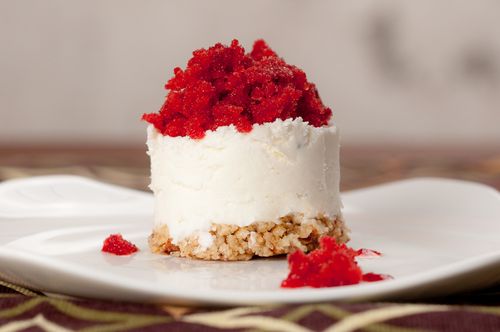A Funny Little Cheese Course – Recipe

This was just pure play. I wanted to see if I could do a cheese course that would look like cheesecake, but not be particularly sweet. I landed on a Laura Chenel chevre with a little salty crust and strawberry granita.
A cheese course, like an amuse bouche or a tapa is an opportunity to be a little less constrained, because you don’t need to make something that would be appropriate in an entree-sized portion. You can use bold flavors and surprising combinations without rapidly tiring the palate.
The strawberry component has one ingredient: strawberries. I just pureed the heck out of them and then made a simple granita by stirring/raking them with a fork every 15 minutes or so until frozen. The stirring keeps the ice crystals small and smooth. Needless to say you want to use exceptional strawberries for this; don’t even bother if you only have hard tasteless berries that made a 2000 mile trip to your grocery store.
I wanted to pay homage to the classic graham cracker crust of a cheesecake, but go salty instead of sweet. I landed on coarsely pulverized rice crackers and mini-pretzels with a little butter, fennel pollen and black pepper.
Goat Cheese with Strawberry Granita and a Pretzel Crust
Vegetarian
Serves 4 as a cheese course
- 1 cup strawberries, hulled
- 25 g. rice crackers (I used the wafer-shaped ones from Trader Joe’s)
- 10 g. mini-pretzels
- 25 g. unsalted butter
- big pinch of fennel pollen
- few grinds black pepper
- 3/4 c. chevre (preferably Laura Chenel brand)
- Puree the strawberries thoroughly. Place them in a shallow plastic container in your freezer. Every fifteen minutes or so, give them a stir with a fork, raking through the ice crystals to break them up. In about two hours or less you should have a nicely frozen granita.
- In a mini food processor, combine the rice crackers, pretzels, butter, fennel pollen and black pepper. Process until you have fairly uniform small crunchy bits, say 1/4 – 1/2 the size of a grain of puffed rice cereal. Taste and mix in a little more salt if needed.
- To serve, spray or rub a 1″ ring mold with a light coating of oil and place it on a plate. Press in a 1/2″ layer of the crust mixture. Top that with 3 tablespoons of the chevre, again, presing it into the mold, then gently push the “cheesecake” out of the mold. Repeat for the remaining plates. Remove the granita from the freezer and scrape it with the fork again to restore the texture. Top each plate with a tablespoon or so of the granita and serve immediately.

this i will definitly try! i am intrigued by the combination of crunchy and creamy in a cheesecake, but i am not such a fan of sweets, so this savoury version is right up my alley 🙂
This just might be the most original use for goat cheese I’ve ever come across. I love it, especially the inclusion of fennel pollen. How is it that I am just now discovering your blog? Beautiful. I’m inspired.
Though I don’t eat cheese, this does sound very interesting. I can just imagine the tanginess of the chevre melding with the saltiness of the pretzels and the sweetness of the strawberries. Very creative!
Gorgeous photo! The pretzel crust is so original, I’ll definitely have to try this!
Absolutely amazing idea!
Oh, how lovely! When I first saw the photo, I thought the red was caviar… which really threw me in light of the fact that you are vegetarian. 😉 Great idea for a cheese course.
Thanks, Dawn! I thought the same thing about the photo, that it resembled caviar for some reason.
Hi I had no idea of the vast choices of Vegan/Vegetarian Blogs. I just started veggiekorner.wordpress.com. It is so exciting. I do agree a Vegan blog goes beyond the recipes….I call it the vegetarian way…I have been a vegetarian for 38 years and a complete Vegan for almost 20. I am no longer on a soap box about it..I am just being me. Many thanks…
Forgive me if I’ve missed something, but doesn’t most goat cheese, Chenel brand included, have animal rennet in it, thereby making this dish unsuitable for vegetarians?
Dawn – it is a very good question. Cheese can have rennet from animal, vegetable, or microbial sources, and it is very rarely clearly labeled. I've heard anecdotally that the microbial source is cheapest and therefore quite common. Personally, this is the one thing in the lacto-ovo cannon I've chosen to ignore. I know there are many people who go the same route, considering themselves to be vegetarian but eating cheese without finding out what kind of rennet is used, and others who include this in their list of concerns.
Thanks,
Michael
This is so beautiful! I also thought it was red caviar. Salty and sweet is the best thing ever – I must get motivated and serve this in the future. It looks really fancy but seems very easy – a good combination as well.
This is a dazzling little starter!
Thank you for writing so eloquently about the possibility of rennet being present in goat cheese. There’s such a line to dance between concern for animal welfare and a deep appreciate for unique flavors of cheese…